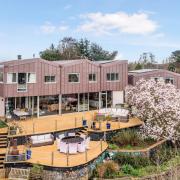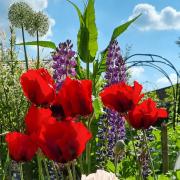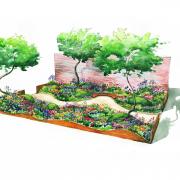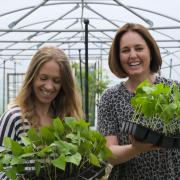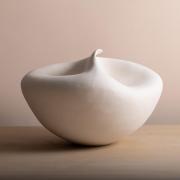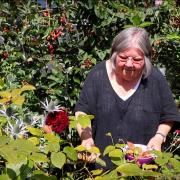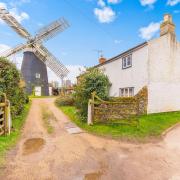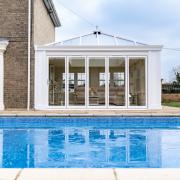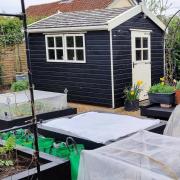We’re really excited that the RSPB Flatford Wildlife Garden will be opening for the season on the March 28 as the garden is springing to life again, ready for visitors to enjoy. The days are getting longer, it’s getting warmer, and the garden plants are beginning to grow, ready to provide food and shelter for the wildlife that’s awakening and needing our support to thrive.

Plants are obviously a big part of any garden, and a good wildlife garden needs a wide variety of flowering plants, which could include annuals, perennials, biennials, shrubs, small trees and climbers, to provide year-round nectar sources for bees, butterflies and other insects.
Early flowering plants provide vital nectar for the queen bumblebees that are emerging from hibernation now, for example Mahonia, an excellent shrub with attractive yellow flowers or Sarcococca ‘Sweet Box’, another shrub with sweetly scented, creamy-white flowers, followed by glossy blackberries.

Native plants that naturally occur in the UK are good as they support an abundance of butterflies, bees and other insects. But plants that are more drought tolerant as they originate from the Mediterranean, including herbs like the spring flowering rosemary, and thyme, oregano and marjoram that flower in the summer and are excellent for bees and butterflies later in the year.
Different insects feed on different shaped flowers – some need open, flat flowers, such as daisies left in the lawn. Foxgloves have tube shaped flowers that bumble bees enjoy, and some flowers are almost designed to cater for a specific bee or insect – Verbena Bonariensis or ‘Buddleia’ are ideal for Hummingbird Hawkmoths with their long feeding tube. These hovering moths are becoming increasingly common in the UK due to our warming climate.

Bees are good at getting into flowers that maybe they’re not designed to. Penstemons have fairly small tube-shaped flowers. Some of the larger bees cannot get up into the tube, so they pierce the top of the flower with their proboscis – their feeding tube – to get directly to the nectar without fertilising the flower. Scented flowers are best. Insects know they’ll have nectar, and single flowers enable the bees to get to the pollen easily. Double flowers, such as blowsy roses may look good, but don't contain any nectar or pollen.
Sowing wildlife-friendly seeds is a great family activity. Why not have a competition to see whose sunflower grows the tallest or has the most bee visitors?
We can support bees with plants but also in other ways. Did you know, there are 225 species of solitary bee, compared to only 24 species of bumblebee, which lay eggs in single chambers? You can purchase solitary bee houses for your garden or make the habitat yourself. Simply drill holes in spare wood or logs, to a depth of at least 10cms, to create chamber homes for these fascinating creatures. It’s beneficial to provide a range of hole widths between 2mm and10mm in diameter to suit a range of solitary bees.
Bees and most other insects also need to drink. An easy way to provide water for insects is to put out a small, shallow bowl of water, with some stones in it to provide a dry place for the bee to land. That way they can then drink without risking falling into a larger pond. Remember to top up shallow bowls as they dry out.

Butterflies will be appearing in gardens around now. Some overwinter as adults, such as the Brimstones that you see in April, or as a chrysalis, like the other early butterfly, the Orange Tip.
A garden highlight at the Flatford Visitor Centre, is watching Blue Tits and Great Tits nest building on the live nestcam TVs. Female Blue Tits lay, on average, 8 to 12 eggs, but they can lay as many as 16. Each chick needs up to 100 caterpillars to eat every day, resulting in some very busy Blue Tit parents. We can help in our gardens by providing plants and trees for butterflies to lay eggs so there are plenty of caterpillars to feed hungry baby Blue Tits. As the Blue Tit chicks grow their diet includes spiders and beetles.


Hedgehogs will wake up from their long hibernation in the spring. It’s important we don’t tidy away all winter debris as hedgehogs need leaves and twigs for nest building and tall grass and logs for shelter. Whatever you do in your garden to help wildlife, be it big or small, remember to take time to enjoy the view and see what wildlife visits.
If you live near us or are visiting south Suffolk, please visit the RSPB Flatford Wildlife Garden; we would love to talk about wildlife gardening with you. The garden is open every day from the March 28 to the end of October, and hosts lots of nature themed family friendly events during the year. Find out more at rspb.org.uk/flatford

Make a wildlife pond
Spring is a great time to make a wildlife pond in your garden and it doesn’t need to be big. Half a barrel, or even an old washing up bowl buried in the ground so that the edge is at ground level, would be ideal. It’s always best to allow it to fill up with rainwater if possible; if you have a water butt, you can use rainwater from that.
Avoid using tap water, if possible, as it has additional nutrients that will discourage aquatic plants and encourage growth of algae and duckweed, upsetting the natural balance of a new pond.
To complete the pond you just need a couple of plants around the edge and some oxygenating plants in the pond itself, plus a large stone or small ramp in the water so hedgehogs or mice that may fall in can escape. Before you know it, you'll be watching dragonflies gliding over the surface and laying their eggs on the plants, or you may spot a frog popping its head out of the water.










